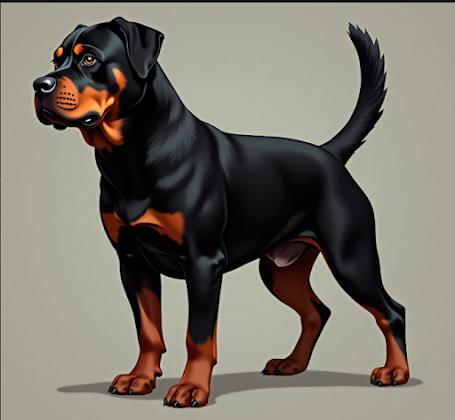🐕Rottweiler vs. Rottweiler: A Deep Dive Into the Breed's Evolution
Rottweilers are one of the most iconic dog breeds in the world—but did you know that not all Rotties are the same? Over time, different breeding goals have led to distinct variations within the breed. In this post, we explore the old working-line Rottweilers, modern show-line types, and the so-called "Roman Rottweilers," diving deep into what sets them apart.
⏰ The Original Rottweiler (Old-Type / Working-Line)
Appearance:
Medium size, agile and compact
Head: Balanced, not overly large
Muzzle: Moderate length, slightly tapered
Coat: Coarser and darker, sometimes longer than show lines
Temperament:
High drive, alert, and task-focused
Extremely loyal, reserved with strangers
Less cuddly, more utilitarian
Purpose: Originally bred for herding, protection, and hauling carts. These dogs were working machines—tough, intelligent, and determined.
🏅 Modern Show-Line Rottweiler
Appearance:
Broad, blocky head
Short, thick muzzle
Stockier chest and compact frame
Rich mahogany markings, silkier coat
Temperament:
Balanced and confident
Trainable and people-friendly
Ideal for family settings
Purpose: Bred for conformation shows, companionship, and controlled protection work. These Rotties shine in both the ring and the home.
🧤 Roman Rottweiler (Oversized / Giant Type)
Appearance:
Extremely large, often exceeding 135 lbs
Oversized head with droopy jowls
Broad chest, mastiff-like features
Temperament:
Often calm, sometimes aloof
Varies widely based on breeding
Purpose: Sometimes bred for intimidation or novelty. This type is not recognized by major breed standards and can carry significant health risks.
🧠 Key Differences at a Glance
| Trait | Old Working-Line | Modern Show-Line | Roman/Giant |
|---|---|---|---|
| Head Size | Proportional | Broad, blocky | Oversized |
| Muzzle | Moderate | Short, thick | Heavy, droopy |
| Body Type | Lean, agile | Thick, compact | Massive, bulky |
| Drive Level | Very high | Moderate | Low to moderate |
| Temperament | Focused, serious | Balanced, trainable | Varies |
| Health Risk | Lower | Balanced | Higher (joints, heart) |
📸 Visual Comparisons Coming Soon!
We’re working on a visual side-by-side chart to help you identify different Rottie types by appearance. Stay tuned!
❤️ Why It Matters
Training Needs: High-drive dogs need more structure.
Health Planning: Giant types can suffer from heart or joint issues.
Lifestyle Fit: Not all Rotties are suited for the same type of owner.
Knowing what type of Rottweiler you’re dealing with can make a world of difference in how you train, care for, and connect with them.
🔠 Final Thoughts: Know Your Rott, Respect the Line
Whether you prefer the lean, work-ready old type, the proud and powerful show-line, or the commanding Roman giant, one truth remains:
"A Rottweiler’s loyalty is built in but their potential is shaped by you."
Choose the right type for your lifestyle, and commit to being the owner your dog believes you are.
follow me on Instagram: Instagram





.jpeg)
Comments
Post a Comment